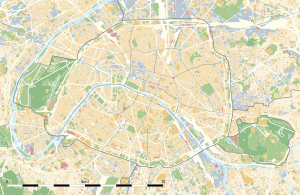Gare d'Orsay | |||||
|---|---|---|---|---|---|
| Heavy rail | |||||
 1909 postcard: "La Gare d'Orleans (the Gare d'Orsay) et Quai d'Orsay" | |||||
| General information | |||||
| Location | Quai d'Orsay/Rue de Lille 75343 Paris, France | ||||
| Coordinates | 48°51′37″N 2°19′31″E / 48.860283°N 2.325392°E | ||||
| Owned by |
| ||||
| Line(s) | Paris–Bordeaux railway | ||||
| Tracks | 16 | ||||
| Construction | |||||
| Architect | Victor Laloux | ||||
| Architectural style | Beaux-Arts | ||||
| History | |||||
| Opened | 1900 | ||||
| Closed | 1939 | ||||
| Previous names | Gare d'Orléans (Quai d'Orsay) | ||||
| Key dates | |||||
| 1986 | Reopened as the Musée d'Orsay | ||||
| |||||
The Gare d'Orsay (French: [ɡaʁ dɔʁsɛ]) is a former Paris railway station and hotel, built in 1900 to designs by Victor Laloux, Lucien Magne and Émile Bénard; it served as a terminus for the Chemin de Fer de Paris à Orléans (Paris–Orléans railway). It was the first electrified urban terminal station in the world, opened 28 May 1900, in time for the 1900 Exposition Universelle.[1]
After its closure as a station, it reopened in December 1986 as the Musée d'Orsay, an art museum. The museum is currently served by the RER eponymous station.
- ^ Baer, Christopher T. (March 2005). "PRR Chronology" (PDF). The Pennsylvania Railroad Technical & Historical Society. p. 10. Archived from the original (PDF) on 4 February 2012. Retrieved 16 July 2010.
